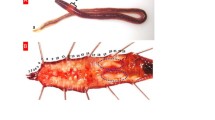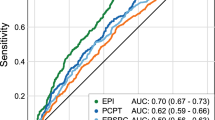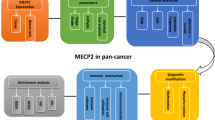Abstract
Direct transrectal delivery of therapeutic genes utilizing adenoviral vectors for advanced prostate cancer may offer effective treatment at the molecular level. Large animal models to assess feasibility and the intraprostatic and systemic dissemination patterns of these vectors have not been reported. For these studies, a replication-deficient (E1−/E3−) recombinant adenovirus (AdRSVlacZ) expressing bacterial β-galactosidase (β-gal) was delivered under transrectal ultrasound guidance. Two prostate biopsies, followed by concurrent injection of 4.8×109 pfu of the adenoviral vector divided into either 1 or 2 mL of diluent, were performed (n=4). Swabs of the rectum, sputum, and urine were collected and after 72 hours, the animals were sacrificed. Specimens were assayed for the presence of virus and β-gal activity. Rectal swabs were transiently positive, whereas urine and sputum samples showed no detectable vector throughout the experiment. β-gal activity was observed at the prostate injection sites with detectable activity noted up to 7.5 mm away from the injection site. Systemic dissemination was observed regardless of the injected volume. In conclusion, transrectal prostate biopsy with concurrent prostate injection is a feasible method to deliver therapeutic adenoviral vectors for the treatment of prostate cancer; however, systemic distribution and temporary rectal shedding of virus should be anticipated.
This is a preview of subscription content, access via your institution
Access options
Subscribe to this journal
Receive 12 print issues and online access
$259.00 per year
only $21.58 per issue
Buy this article
- Purchase on SpringerLink
- Instant access to full article PDF
Prices may be subject to local taxes which are calculated during checkout


Similar content being viewed by others
References
Greenlee RT, Hill-Harmon MB, Murray T et al. Cancer statistics CA Cancer J Clin 2001 51: 15–36
Kleinerman DI, Zhang WW, Lin SH et al. Application of a tumor suppressor (C-CAM1)–expressing recombinant adenovirus in androgen-independent human prostate cancer therapy: a preclinical study Cancer Res 1995 55: 2831–2836
Yang C, Cirielli C, Capogrossi MC et al. Adenovirus-mediated wild-type p53 expression induces apoptosis and suppresses tumorigenesis of prostatic tumor cells Cancer Res 1995 55: 4210–4213
Shariat SF, Desai S, Song W et al. Adenovirus-mediated transfer of inducible caspases: a novel “death switch” gene therapeutic approach to prostate cancer Cancer Res 2001 61: 2562–2571
Rodriguez R, Schuur ER, Lim HY et al. Prostate-attenuated replication-competent adenovirus (ARCA) CN706: a selective cytotoxic for prostate-specific antigen-positive prostate cancer cells Cancer Res 1997 57: 2559–2563
Hall SJ, Mutchnik SE, Chen SH et al. Adenovirus-mediated herpes simplex virus thymidine kinase gene and ganciclovir therapy leads to systemic activity against spontaneous and induced metastasis in an orthotopic mouse model of prostate cancer Int J Cancer 1997 70: 183–187
Siegfried W . Perspectives in gene therapy with recombinant adenoviruses Exp Clin Endocrinol 1993 101: 7–11
Wood M, Perrotte P, Onishi E et al. Biodistribution of an adenoviral vector after intravesical administration in a mouse model Cancer Gene Ther 1997 4: S34
Culver KW . Methods for gene transfer and repair In: Culver KW, editor. Gene Therapy: A Primer for Physicians 2nd ed Larchmont, NY: Mary Ann Lievert 1996 19–37
Stratford-Perricaudet LD, Makeh I, Perricaudet M et al. Widespread long-term gene transfer to mouse skeletal muscles and heart J Clin Invest 1992 90: 626–630
Steiner MS, Gingrich JR . Gene therapy for prostate cancer: where are we now? J Urol 2000 164: 1121–1136
Mitchell MF, Hamada K, Sastry KJ et al. Transgene expression in the Rhesus cervix mediated by an adenovirus expressing beta-galactosidase Am J Obstet Gynecol 1996 174: 1094–1101
Hashimoto M, Aruga J, Hosoya Y et al. A neural cell-type–specific expression system using recombinant adenovirus vectors Hum Gene Ther 1996 7: 149–158
Quantin B, Perricaudet LD, Tajbakhsh S et al. Adenovirus as an expression vector in muscle cells in vivo Proc Natl Acad Sci USA 1992 89: 2581–2584
Arbuthnot PB, Bralet MP, Le Jossic C et al. In vitro and in vivo hepatoma cell–specific expression of a gene transferred with an adenoviral vector Hum Gene Ther 1996 7: 1503–1514
Byrnes AP, Rusby JE, Wood MJ et al. Adenovirus gene transfer causes inflammation in the brain Neuroscience 1995 66: 1015–1024
Lu Y, Carraher J, Zhang Y et al. Delivery of adenoviral vectors to the prostate for gene therapy Cancer Gene Ther 1999 6: 64–72
Ko S-C, Gotoh A, Thalmann GN et al. Molecular therapy with recombinant p53 adenovirus in an androgen-independent, metastatic human prostate cancer model Hum Gene Ther 1996 7: 1683–1691
Nyberg-Hoffman C, Shabram P, Li W et al. Sensitivity and reproducibility in adenoviral infectious titer determination Nat Med 1997 3: 808–811
Herman JR, Adler HL, Aguilar-Cordova E et al. In situ gene therapy for adenocarcinoma of the prostate: a phase I clinical trial Hum Gene Ther 1999 10: 1239–1249
Logothetis CJ, Hossan E, Pettaway CA et al. AD–p53 intraprostatic gene therapy preceding radical prostatectomy (RP): an in vivo model for targeted therapy development Paper presented at AUA 94th Annual Meeting, Dallas, TX 1999
Steiner MS, Lerner J, Greenberger M et al. Clinical phase I gene therapy trial using BRCA1 retrovirus is safe J Urol 1998 159: 133
Patel B, Naitoh J, Stiles A et al. Effect of interleukin-2 (IL-2) gene therapy on prostate-specific antigen in patients undergoing neoadjuvant or adjuvant gene therapy for prostate cancer Paper presented at AUA 94th Annual Meeting, Dallas, TX 1999
Simons JW, Jaffee EM, Weber CE et al. Bioactivity of autologous irradiated renal cell carcinoma vaccines generated by ex vivo granulocyte–macrophage colony-stimulating factor gene transfer Cancer Res 1997 57: 1537–1546
Sanda MG, Smith DC, Charles LG et al. Recombinant vaccinia-PSA (PROSTVAC) can induce a prostate-specific immune response in androgen-modulated human prostate cancer Urology 1999 53: 260–266
Chen AP, Bastian A, Dahut W et al. A phase I study of recombinant vaccinia virus that expresses prostate-specific antigen (PSA) in adult patients with adenocarcinoma of the prostate Paper presented at Proc Am Soc Clin Oncol, Los Angeles 1998
Eder J, JP, Kantoff PW et al. A phase I trial of recombinant vaccinia virus, PROSTVAC that expresses prostate-specific antigen (rV-PSA) as a vaccine in men with advanced prostate cancer Paper presented at Proc Am Soc Clin Oncol, Los Angeles 1998
Siemens DR, Austin JC, Hedican SP et al. Viral vector delivery in solid-state vehicles: gene expression in a murine prostate cancer model J Natl Cancer Inst 2000 92: 403–412
Hall SJ, Bar-Chama N, Ta S et al. Direct exposure of mouse spermatogenic cells to high doses of adenovirus gene therapy vector does not result in germ cell transduction Hum Gene Ther 2000 11: 1705–1712
Paielli DL, Wing MS, Rogulski KR et al. Evaluation of the biodistribution, persistence, toxicity, and potential of germ-line transmission of a replication-competent human adenovirus following intraprostatic administration in the mouse Mol Ther 2000 1: 263–274
Herz J, Gerard RD . Adenovirus-mediated transfer of low density lipoprotein receptor gene acutely accelerates cholesterol clearance in normal mice Proc Natl Acad Sci USA 1993 90: 2812–2816
Author information
Authors and Affiliations
Corresponding author
Rights and permissions
About this article
Cite this article
Weld, K., Mayher, B., Allay, J. et al. Transrectal gene therapy of the prostate in the canine model. Cancer Gene Ther 9, 189–196 (2002). https://doi.org/10.1038/sj.cgt.7700425
Received:
Published:
Issue date:
DOI: https://doi.org/10.1038/sj.cgt.7700425



